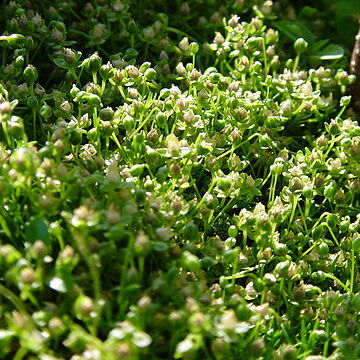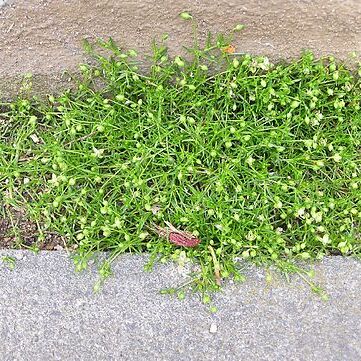Annual or perennial, usually small herbs, glabrous or glandular hairy, richly branched, forming loose tufts or mats, or dense cushions. Stems often filiform. Leaves exstipulate, very narrow, opposite, slightly connate at the base, with or without ciliate margin. Flowers axillary, solitary or in few-flowered cymes; pedicels glabrous or hairy, very thin. Sepals 4 or 5, erect or patent. Petals white, 4 or 5, entire, ovate or obovate, sometimes minute or absent. Stamens 4-5 or 8-10, the inner episepalous with a nectarial gland at the base. Ovary ovoid; ovules numerous; styles same number as sepals. Capsule ovoid to cylindrical, opening ± to the base by 4 or 5 valves. Seeds numerous, very small (0.2-0.5 mm), dark brown, reniform, papules.
Herbs annual, biennial, or perennial, small. Stems often caespitose, procumbent or ascending, slender. Leaves linear or subulate, basally connate; stipules absent. Flower solitary, axillary or terminal, rarely in cymes, small, pedicellate; bracts immediately subtending calyx absent. Sepals 4 or 5. Petals 4 or 5, sometimes absent, white, usually shorter than sepals, rarely equal, margin entire, rarely slightly emarginate. Stamens 4 or 5, sometimes 8 or 10. Ovary 1-loculed; ovules numerous; styles 4 or 5, alternating with sepals. Capsule ovoid to globose, 4-or 5-valved; valves opposite sepals. Seeds numerous, reniform, minute, tuberculate or smooth; embryo curved.
Herbs, annual or perennial, often tufted, glabrous, ciliate or sparsely glandular-hairy. Leaves distant on stems, opposite, sessile, subulate to linear-lanceolate; stipules absent. Flowers solitary, bisexual, 4-or 5-merous; bracts herbaceous or with narrow, scarious margins. Sepals 4 or 5, cucullate, free. Petals 4 or 5, usually white, entire, often minute or absent. Stamens 4 or 8, rarely 5 or 10. Ovary 1-celled, with many ovules; styles 4 or 5. Capsule ovoid to subglobose, splitting almost to base into as many valves as styles. Seeds numerous, minute, ± reniform to obovoid or subglobose, with or without a dorsal groove, ± tuberculate.
Annual to perennial herbs. Hairs eglandular or glandular or 0. Cauline lvs usually opposite, exstipulate, linear to subulate, connate at base. Fls solitary, terminal or axillary; bracts leaflike; epicalyx 0. Sepals 4-5, free with narrow scarious margin. Petals 4-5, white, entire, 1-2× length of sepals or vestigial or 0; coronal scales 0. Stamens in 1-2 whorls of 4-5, outer whorl opposite sepals. Styles 4-5. Fr. an ovoid many-seeded capsule, 4-5-valved, dehiscing to base. Seeds triangular-ovoid or reniform to subglobose, smooth, papillate or tuberculate, not winged.
Tufted, sometimes cushion-like, or procumbent herbs. Leaves narrowly linear or subulate, exstipulate. Flowers small and relatively inconspicuous. Sepals 4–6, green. Petals as many as sepals and alternating with them, or absent; when present white, often small and shorter than the sepals. Stamens usually 5–10 but the number may vary. Ovary unilocular, with an indefinite number of ovules; styles as many as the sepals and alternating with them. Capsule opening to the base into as many valves as there are styles.
Fls solitary and terminal or axillary , or in terminal cymes; sep mostly 5 or 4; pet as many as the sep, white, entire or emarginate, or none; stamens as many as and opposite the sep, or twice as many; styles as many as and alternate with the sep; valves of the capsule opposite the sep; seeds numerous, minute; low, matted, delicate annuals or perennials with opposite, basally connate, narrow (often linear-subulate) lvs, lacking stipules. 15, mostly cold-temp. N. Hemisphere.


